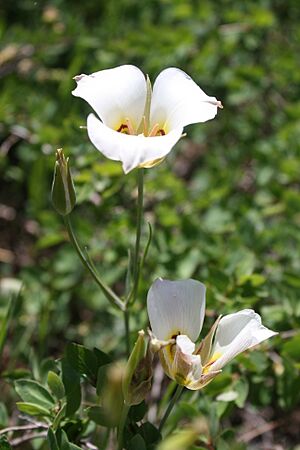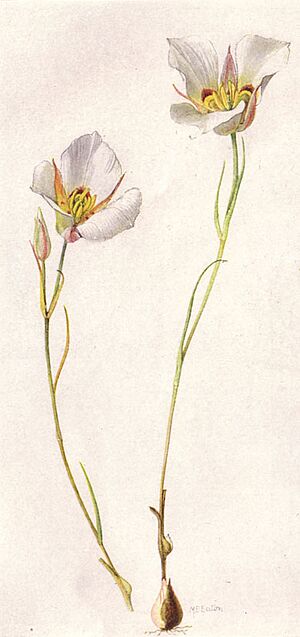Sego lily facts for kids
Quick facts for kids Sego lily |
|
|---|---|
 |
|
| Scientific classification | |
| Genus: |
Calochortus
|
| Species: |
nuttallii
|
| Synonyms | |
|
|

The sego lily (its scientific name is Calochortus nuttallii) is a beautiful plant that grows from a bulb. It's a perennial plant, meaning it lives for more than two years. You can only find it growing naturally in the Western United States.
This special flower is the state flower of Utah.
Contents
Where Sego Lilies Grow
The sego lily grows naturally in many western states. You can find it all over Utah and Wyoming. It also grows in large parts of eastern Nevada. You might also spot it in parts of Idaho, Montana, North Dakota, South Dakota, Nebraska, Colorado, Arizona, and New Mexico.
What Sego Lilies Look Like
Sego lilies usually grow to be about 15 to 45 centimeters (6 to 18 inches) tall. They have long, thin leaves.
Each plant has 1 to 4 flowers. Each flower has three white petals and three sepals. The petals often have a light purple color, sometimes even magenta. There's also a purplish band that starts from the yellow center of the flower.
Sometimes, you can find sego lilies with yellow petals and dark purple bands. These have been seen in places like Petrified Forest National Park. They were also spotted during a "super bloom" in Utah in 2019. The flowers bloom in early summer and can be up to 3 inches wide.
How Sego Lilies are Classified
The sego lily, Calochortus nuttallii, belongs to a group of flowers called Calochortus. This group is often known as Mariposa Lilies.
The plant's scientific name, nuttallii, honors an English botanist named Thomas Nuttall. Two American botanists, John Torrey and Asa Gray, officially described the species in 1857.
How People Use Sego Lilies
Sego Lilies as Food
Long ago, Native American tribes used parts of the sego lily for food. They ate the bulbs, seeds, and even the flowers. Tribes like the Hopi, Havasupai, Navajo, Southern Paiute, Gosiute, and Ute peoples would roast or boil the bulbs. They also made the bulbs into a porridge. The Hopi tribe used the yellow flowers in their ceremonies.
When Mormon pioneers first arrived in Utah, they learned from the Shoshone people how to use the sego lily bulbs for food. This was very important because they needed food badly. Because of this, the sego lily was officially named the Utah State Flower in 1911. The word sego comes from the Shoshone word seego.
The sego lily was even honored by a special project in Salt Lake City. In 2017, the Sego Lily Dam was built in Sugar House Park. It's a flood-prevention project shaped like a giant sego lily!
Growing Sego Lilies
People also grow Calochortus nuttallii in gardens because its tulip-shaped flowers are very pretty. Growing them helps attract and support native pollinators like bees.
Sego lilies like sandy soil that drains water well. They can also handle cold weather. You can grow new plants from small bulbs that form on the parent plant. These new bulblets usually take about two years to bloom.
|


